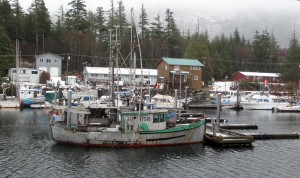Seismologist visits Southeast in wake of large earthquake
January 31, 2013

Ned Rozell
1/31/2013
CRAIG — In this cozy Southeast Alaska community that smells of red cedar chips used to power a boiler that heats both the school and the pool, seismologist Natalia Ruppert responded to an hour of questions from more than 150 people who gathered in the auditorium of the Craig High School.
The residents of Craig and the outlying areas, many of them wearing Xtratufs and flannel shirts on a rainy/snowy evening, had experienced up to a minute of shaking around midnight on Jan. 4, 2013, the result of a magnitude 7.5 earthquake that ripped the sea floor about 80 miles west of Craig.
One-hundred-and-seventy people — about one-tenth of the population of Craig and the nearby village of Klawock, were a rapt audience for Ruppert, an earthquake expert with the University of Alaska Fairbanks’ Geophysical Institute.
Ruppert traveled to Craig from her home in Fairbanks at the invite of U.S. Forest Service Geologist Jim Baichtal, who lives in Thorne Bay, also on Prince of Wales Island. Baichtal invited Ruppert down, and hosted her at his lovely new home above Thorne Bay, because his “phone was ringing off the hook” after the earthquake and many aftershocks that followed. People were calling one of the few scientists on the island for information; he called north for help.
In a 45-minute lecture and the lengthy question and answer session that followed, Ruppert, the seismic network manager for the Alaska Earthquake Information Center based at the Geophysical Institute, told her attentive audience the following:
- The earthquake released most of its energy in the first 20 seconds, but it took 50 seconds for 85 miles of the Queen Charlotte Fault to rupture. The fault slices Earth’s in a north-south swath just west of Southeast Alaska. Ruppert said some residents felt shaking for longer than that because seismic waves take longer to travel through the ground. The great Alaska earthquake of 1964, by comparison, tore the sea floor for six full minutes.
- The Craig earthquake differed from the magnitude 9.2 1964 earthquake in that the Queen Charlotte Fault produces “strike-slip” earthquakes, in which the release of stress along the fault happens in a side-to-side motion similar to when you rub your hands together. The Craig earthquake did not cause the sea floor to thrust upward, which is why it did not produce a noticeable tsunami.
- In the two weeks following the earthquake, residents of Prince of Wales Island experienced about 20 aftershocks of magnitude 4, about the smallest earthquake people could feel that distance from the fault.
- More than 900 people in Southeast Alaska reported feeling the earthquake on the U. S. Geological Survey’s “Did You Feel It?” webpage. People felt the earthquake as far south as Seattle.
- Aftershocks will become less frequent for the islanders as time passes. “Within the next six months, you can expect between four and 10 magnitude four or greater aftershocks,” Ruppert said.
- “It’s very possible” that a magnitude 7.7 earthquake farther south on the same fault in October 2012 may have triggered the Craig earthquake.
- The Craig earthquake did not trigger any volcanic activity.
- If people don’t have an assigned area to gather when evacuating their homes to avoid a possible tsunami, they should travel uphill. “The higher the better,” Ruppert said. “You never know.”
- Though almost the entire Alaska portion of the Queen Charlotte Fault released stored energy by rupturing in previous earthquakes within the past century (including a whopping magnitude 8.1 in 1949), Southeast residents “should be aware,” Ruppert said. “It’s a big fault in your backyard. It’s not if (you’ll have another earthquake), it’s when.” Addition at column-deadline time: One day after Ruppert flew home to Fairbanks from Southeast, a magnitude 6 earthquake occurred just 70 miles offshore of Craig.
Since the late 1970s, the University of Alaska Fairbanks' Geophysical Institute has provided this column free in cooperation with the UAF research community. Ned Rozell is a science writer for the Geophysical Institute.


